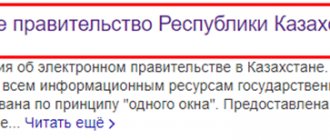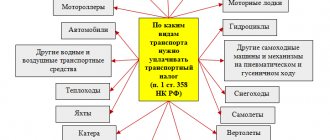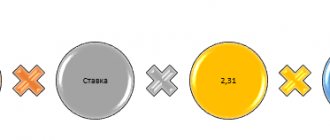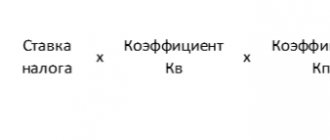Everyone who has a vehicle registered to them and who does not have the appropriate benefits must pay vehicle tax. An individual is a transport tax payer if a vehicle is registered to him: a car, motorcycle, scooter, snowmobile, water or other transport listed in Art. 358 of the Tax Code of the Russian Federation (Article 357 of the Tax Code of the Russian Federation).
Thus, payers of this tax are considered to be persons who own a car, motorcycle, bus and other shipping vehicles that have tires.
Please note that if an individual sold a car by proxy, the car remains registered in his name and he is the payer of transport tax on this car.
This tax is paid annually.
But there are also exceptions, or so-called benefits - disabled people do not pay this tax for specially equipped cars and wheelchairs.
Notification from the tax office with transport tax calculation
Transport tax for individuals is calculated by the tax office, which must send you a notification with the amount of the tax and the data on the basis of which it was calculated (clause 1 of Article 362, clause 3 of Article 363 of the Tax Code of the Russian Federation).
Information about the vehicle, its characteristics, owner and registration period is submitted to the tax office by the body that carries out state registration of certain vehicles.
For example, state registration of motor vehicles is carried out by traffic police units, which transmit data to the tax authorities (clause 4 of article 85 of the Tax Code of the Russian Federation; Regulations on the interaction of departments of the State Traffic Inspectorate and tax authorities when submitting information about vehicles and the persons on whom they are registered, approved by the Order Ministry of Internal Affairs of Russia N 948).
Calculation of transport tax
The amount of transport tax is calculated for each vehicle based on five components.
1. Tax base - the value established for calculating the tax depending on the type of vehicle.
For cars, motorcycles, self-propelled watercraft, and other vehicles with an engine, this is the engine power in horsepower; for non-self-propelled (towed) water vessels - this is the gross tonnage in registered tons, etc. (Clause 1 of Article 359 of the Tax Code of the Russian Federation).
These characteristics are indicated in technical documents for transport, in the vehicle passport and in the registration certificate.
2. Share in the ownership of the vehicle. If there is only one owner, the share in the right is taken as one; if there are several, its part is taken for a specific taxpayer (1/2, 1/3, etc.).
3. Tax rate. It is established by the laws of the constituent entities of the Russian Federation per one horsepower of engine power, one registered ton of gross tonnage of a non-propelled vessel, etc. (Article 361 of the Tax Code of the Russian Federation).
Transport tax rates can be found in the law of the subject of the Russian Federation where the vehicle is registered.
If such a law has not been adopted in the region or rates have not been established in it, then the rates specified in paragraph 1 of Art. 361 Tax Code of the Russian Federation.
4. The period for which the tax is calculated. The default is the previous calendar year.
If the vehicle has been registered to you for the entire year, the value is taken equal to one.
If only part of a year, the period is defined as the ratio of the number of full months during which the vehicle was registered to you to the number of calendar months in the year.
When calculating transport tax for tax periods starting from 2016, the month of registration of the vehicle (month of deregistration of the vehicle) is taken as a full month if the registration (deregistration) of the vehicle occurred before the 15th day of the corresponding month inclusive.
If the registration of the vehicle occurred after the 15th day of the corresponding month or the deregistration of the vehicle (deregistration, exclusion from the state ship register, etc.) occurred before the 15th day of the corresponding month inclusive, the month of registration (deregistration) of the vehicle funds are not taken into account when determining the period.
(Clause 3 of Article 362 of the Tax Code of the Russian Federation; Part 10 of Article 4 of the Law of December 29, 2015 N 396-FZ).
The date of registration of the vehicle can be found in the registration certificate (clause 1 of Article 360, clause 3 of Article 362 of the Tax Code of the Russian Federation).
5. Increasing factor. The tax amount is calculated taking into account the increasing coefficient for passenger cars costing over 3 million rubles. with the corresponding year of manufacture.
So, for example, in relation to passenger cars costing from 3 million rubles. up to 5 million rubles inclusive, the increasing coefficient will be (clause 2 of Article 362 of the Tax Code of the Russian Federation):
- 1.1 - if two to three years have passed since the year of manufacture of the car;
- 1.3 - if one to two years have passed since the year of manufacture of the car;
- 1.5 - if no more than a year has passed since the car was manufactured.
The list of passenger cars with an average cost of 3 million rubles, subject to use in the next tax period, is posted annually no later than March 1 of the next tax period on the official website of the Ministry of Industry and Trade.
The amount of transport tax is calculated as the product of the above five components. The tax notice sent by the tax office indicates all the values necessary for the calculation and the final tax amount.
Example. Calculation of transport tax
We will calculate the tax on a car owned by a citizen, which is registered with the Moscow State Traffic Safety Inspectorate.
Initial data:
- Engine power - 140 hp. With.
- There is only one owner.
- Tax rate - 35 rubles/l. With. (Article 2 of the Law of Moscow dated 07/09/2008 N 33).
- Registered in October 2016 (which means it was registered for three full months out of 12).
- The car was produced in 2016, its cost is 4 million rubles, it is included in the list of passenger cars with an average price of 3 million rubles.
Formula for calculating transport tax for 2016: 140 x 1 x 35 x 3/12 x 1.5 = 1838 rubles.
Who pays transport tax in 2016
Transport, as a rule, is registered to the owner, who can be either a private person or an enterprise. All vehicle owners are required to pay transport tax in accordance with Article 357 of the Tax Code of the Russian Federation (hereinafter referred to as the Tax Code of the Russian Federation).
There is a small category of vehicle owners who may be exempt from paying tax by law of a constituent entity of the Russian Federation in accordance with Articles 356, 357 of the Tax Code of the Russian Federation.
Which vehicles are subject to tax are listed in paragraph 1 of Article 358 of the Tax Code of the Russian Federation. Here is the list:
- cars;
- motorcycles;
- scooters;
- buses;
- aircraft;
- helicopters;
- motor ships;
- yachts;
- boats;
- motor boats;
- jet skis, etc.
The following are not subject to transport tax in accordance with paragraph 2 of Article 358 of the Tax Code of the Russian Federation:
- rowing boats;
- motor boats with engines up to 5 hp. With.;
- cars for disabled people;
- fishing sea and river vessels;
- tractors, self-propelled combines, special vehicles (milk tankers, livestock tankers, etc.), if such machines are used for the production of agricultural products;
- passenger and cargo sea, river and aircraft vessels, if the main activity of the vehicle owner’s company is the transportation of passengers and cargo.
Deadline for payment of transport tax
Payment deadlines are established by the laws of the constituent entities of the Russian Federation.
In this case, the tax must be paid no later than December 1 of the year following the expired tax period (calendar year), starting from the 2015 tax period.
For earlier tax periods (before 2015), the tax should have been paid no later than October 1 of the year following the expired tax period (clause 1 of Article 363, Article 360 of the Tax Code of the Russian Federation; Letter of the Federal Tax Service of Russia dated January 11, 2016 N BS-4 -11/ [email protected] ).
In this case, the notification must be sent no later than 30 days before the specified date (clause 2 of Article 52, clauses 1, 3 of Article 363, clause 4 of Article 397, clauses 1, 2 of Art. 409 of the Tax Code of the Russian Federation; Letter of the Federal Tax Service of Russia dated January 11, 2016 N BS-4-11 / [email protected] ).
When to pay transport tax in 2016
Regional authorities independently establish for enterprises the procedure and terms for payment of transport tax and advance payments. However, the deadline for payment of transport tax is no earlier than February 1 at the end of the reporting year.
Accordingly, in 2016, we pay transport tax for 2015 and the deadline for its payment is no earlier than February 1, 2016.
Transport tax declaration in 2016
Only enterprises that own vehicles report transport tax. This obligation does not apply to private individuals - vehicle owners. The declaration must be submitted to the tax office at the location of the vehicle or at the place of registration of the largest taxpayer. The reporting procedure is established in Article 363.1 of the Tax Code of the Russian Federation.
No later than February 1, 2016, enterprises must submit a transport tax return for 2015 to the tax office.
Companies are required to submit a transport tax return for 2016 to the tax office no later than February 1, 2022.
The transport tax declaration form and the procedure for filling it out were approved by order of the Federal Tax Service of Russia dated February 20, 2012 No. ММВ-7-11/ [email protected]
If the average number of employees for the previous year exceeded 100 people, reporting must be submitted electronically.
Penalties for non-payment
A penalty is a sum of money that will be charged to you for the amount of tax debt if you pay the tax late (Clause 1, Article 75 of the Tax Code of the Russian Federation).
Penalties are calculated according to the formula (clauses 3, 4, Article 75 of the Tax Code of the Russian Federation):
Amount of penalties = amount of tax not paid on time x number of calendar days of delay x 1/300 of the Bank of Russia refinancing rate in effect at that time.
If you do not pay your tax on time, the tax office will send you a demand for payment of arrears of tax and penalties.
Such a requirement must contain: the amount of tax debt; the amount of penalties at the time of sending the claim; tax payment deadline; deadline for fulfilling the requirement; also tax collection measures that will be taken in case of non-compliance with the requirement.
You must pay the amounts specified in the request within eight working days from the date of receipt of the demand, unless a longer period is specified in it (clause 4 of Article 69 of the Tax Code of the Russian Federation).
If a request is sent by registered mail, it is considered received after six days from the date of sending this letter (Clause 6 of Article 69 of the Tax Code of the Russian Federation).
Possible fines
For failure to pay taxes, you may be subject to fines.
The penalty is 20 percent of the unpaid tax amount. If the inspection proves that you did not pay the tax intentionally, then the amount of the fine will increase to 40 percent (Article 122 of the Tax Code of the Russian Federation).
It is important to know that in order to hold you accountable, the tax authority must have evidence that confirms that an offense has been committed.
Namely, have documents stating that the inspectorate calculated the tax in accordance with the law, sent you a tax notice and demand, and has confirmation of the fact and date of receipt of the notice.
Current transport tax rates for 2016: Moscow
For Moscow, the transport tax table for 2016 is given in Article 2 of the capital law. We present the rates for the most common transport facilities (see table).
| Vehicles and tax rates in Moscow | |
| Kind of transport | Rate, rub. |
| Passenger cars with engine power (per horsepower): | |
| up to 100 hp (up to 73.55 kW) inclusive | 12 |
| 100 – 125 hp (73.55 – 91.94 kW) inclusive | 25 |
| 125 – 150 hp (91.94 – 110.33 kW) inclusive | 35 |
| 150 – 175 hp (110.33 – 128.7 kW) inclusive | 45 |
| 175 – 200 hp (128.7 – 147.1 kW) inclusive | 50 |
| 200 – 225 hp (147.1 – 165.5 kW) inclusive | 65 |
| 225 – 250 hp (165.5 – 183.9 kW) inclusive | 75 |
| from 250 hp (over 183.9 kW) | 150 |
| Buses: | |
| up to 110 hp (up to 80.9 kW) inclusive | 15 |
| 110 – 200 hp (80.9 – 147.1 kW) inclusive | 26 |
| from 200 hp (over 147.1 kW) | 55 |
| Trucks: | |
| up to 100 hp (up to 73.55 kW) inclusive | 15 |
| 100 – 150 hp (73.55 – 110.33 kW) inclusive | 26 |
| 150 – 200 hp (110.33 – 147.1 kW) inclusive | 38 |
| 200 – 250 hp (147.1 – 183.9 kW) inclusive | 55 |
| from 250 hp (from 183.9 kW) | 70 |
It is no secret that Moscow generally keeps transport tax rates for 2016 at the highest level compared to other regions of Russia.
Also see “Transport tax rates by region in 2022: table.”
Collection of tax debts (arrears), as well as penalties and fines through the court
If the demand for payment of tax arrears (penalties, fines) is not fulfilled on time, the tax authority may file an application with the court to collect the debt from your property (including funds in bank accounts, cash).
As a general rule, the period for going to court is six months from the date of expiration of the deadline for fulfilling the requirement (clauses 1, 2 of Article 48 of the Tax Code of the Russian Federation). Hello Guest! Offer from "Clerk"
Online professional retraining “Accountant on the simplified tax system” with a diploma for 250 academic hours . Learn everything new to avoid mistakes. Online training for 2 months, the stream starts on March 1.
Sign up









